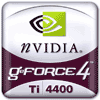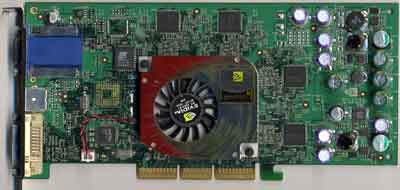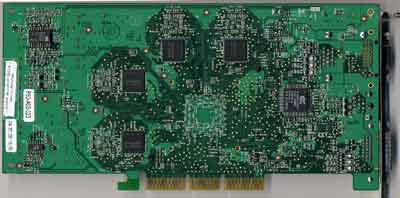NVIDIA GeForce4 - NV17 and NV25 Come to Life
by Anand Lal Shimpi on February 6, 2002 8:51 AM EST- Posted in
- GPUs
The GeForce4 Titanium Lineup
We've taken you this far without mentioning a single product based on the NV25 core, and now we're going to talk about just that. Today the GeForce4 is being introduced in two distinct flavors, the Titanium 4600 and the Titanium 4400. As was the case with the various GeForce3 Titanium cards, the two differ only in their GPU and memory clocks.

 The
GeForce4 Ti 4600 is NVIDIA's new flagship and will feature a 300MHz core clock.
The card will also feature a 128-bit DDR memory bus running at 325MHz
that connects to a total of 128MB of DDR SDRAM. This DDR SDRAM is using
BGA packaging which allows NVIDIA to not only layout the memory on the card
much easier but they actually end up benefiting from reasonably low prices
on 16MB density BGA memory chips in the market.
The
GeForce4 Ti 4600 is NVIDIA's new flagship and will feature a 300MHz core clock.
The card will also feature a 128-bit DDR memory bus running at 325MHz
that connects to a total of 128MB of DDR SDRAM. This DDR SDRAM is using
BGA packaging which allows NVIDIA to not only layout the memory on the card
much easier but they actually end up benefiting from reasonably low prices
on 16MB density BGA memory chips in the market.
The 325MHz memory clock gives the Ti 4600 an incredible 10.4GB/s of raw memory bandwidth which is greater than the previous bandwidth champ, the Radeon 8500 with 8.8GB/s of bandwidth. Also keep in mind that these bandwidth figures aren't taking into account efficiency improvements such as through LMA II on the GeForce4 or HyperZ II on the Radeon 8500.
The GeForce4 Ti 4600 also sports NVIDIA new reference cooling design on the core. The low profile heatsink is coupled with a much more durable fan than NVIDIA's older designs although it's unlikely that third party manufacturers will stick solely to NVIDIA's design. Since the Ti 4600 will become NVIDIA's flagship, you can also expect it to carry NVIDIA's flagship price of $399.
 Just
beneath the Ti 4600 in the product line is the GeForce4 Ti 4400; this card
features a 275MHz GPU clock and a 275MHz DDR memory clock (effectively
550MHz) on the same 128-bit DDR bus. The Ti 4400 will also be shipping with
a 128MB frame buffer using BGA memory. The final decision is up to board manufacturers
as to whether or not they'll use 128MB frame buffers however we don't expect
many to make Ti 4600 or Ti 4400 offerings with 64MB frame buffers at the launch.
Just
beneath the Ti 4600 in the product line is the GeForce4 Ti 4400; this card
features a 275MHz GPU clock and a 275MHz DDR memory clock (effectively
550MHz) on the same 128-bit DDR bus. The Ti 4400 will also be shipping with
a 128MB frame buffer using BGA memory. The final decision is up to board manufacturers
as to whether or not they'll use 128MB frame buffers however we don't expect
many to make Ti 4600 or Ti 4400 offerings with 64MB frame buffers at the launch.
The use of a larger 128MB frame buffer enables game developers to use larger textures without fear of running out of texture memory on the card itself. Another interesting fact is that a 128MB frame buffer enables anti-aliasing at 1600 x 1200 however even with the GeForce4 you won't be able to turn on AA at such a high resolution and expect smooth frame rates in the latest games.
The new cooling system is also present on the Ti 4600 reference board and the cards will carry a $299 price tag.
A third GeForce4 model will be introduced in approximately 8 weeks, and that is the GeForce4 Ti 4200. The Ti 4200 will be identical to the 4600 and 4400 except that it will run at 225MHz core and 250MHz memory. The clock speeds haven't been finalized yet but the truly attractive point of the GeForce4 Ti 4200 is its $199 MSRP. The Ti 4200 will actually end up playing an extremely important role in NVIDIA's lineup but in order to understand why, you'll have to understand the GeForce4 MX - NVIDIA's mainstream graphics part.












1 Comments
View All Comments
jon450 - Friday, September 11, 2020 - link
Woah! I’m really enjoying the template/theme of this blog.https://www.codeboks.com/c-projects-for-beginners-...